The ring system of Saturn was almost fully open in 2003, giving the best
opportunity to image the divisions, but is now beginning to close. The Cassini division is an easy target, but the
Enke division is beyond the resolution of both my telescopes. The Enke minimum is a dark
part of the B ring and is a difficult, but possible, object to record.
The different colours of Saturn in the pictures below are not real. It is difficult
to know what the colour should be. The differences are due to different colour balancing
in the camera and/or modification in processing.
The first image below is the best image I've obtained with the ETX125 and is the oldest.
The rest are in reverse chronological order, so the most recent is at the top.
 |
This is the best image of Saturn I have obtained with my ETX125.
I was very new to imaging at the time and didn't make full notes as
to what I was doing. However I believe the following is what I did.
I am very pleased to have captured the Enke minimum.
This image is upside down (i.e. south at the top) but I'm leaving it that way;
it's prettier!
Date and Time: 19th March 2003 20:22 UT
Set-up: ToUcam 740K on the ETX125
Capture: K3CCDTools. No record of settings
Processing: K3CCDTools, X2, Histogram 14-227, Unsharp Mask 5,0,100
Imported into Registax and wavelets 2-6 set to 10.
|
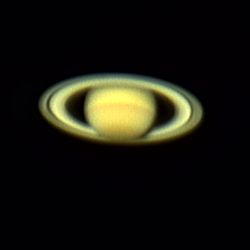 |
Date and Time: 28th October 2003 04:26 UT
Set-up: ToUcam 740K with X2 lens on the LX200
Capture: K3CCDTools, 1010 frames, low gamma, 1/25", 60% gain
Processing: Registax, X2 Mitchell, 564 frames stacked, wavelets 4-6 = 30 , shrunk back to the original size.
|
 |
Date and Time: 12th October 2003 03:37 UT
Set-up: ToUcam 740K with X2 lens on the LX200
Capture: K3CCDTools, 1004 frames, low gamma, 1/25", 67% gain
Processing: Registax, X2 Mitchell, 322 frames stacked, wavelets 4-6 = 10, shrunk back to the original size.
|
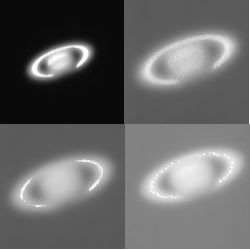 |
These four images of Saturn were shot in the infra-red on the same night as the image above.
They are from different AVI files
and I do not know why the A ring appeared so bright in the infra-red that night.
Date and Time: 12th October 2003 03:49 to 0400 UT
Set-up: ToUcam 740K with X2 lens (except the top-left image) on the LX200
Capture: K3CCDTools, 312-1038 frames, low gamma, 1/25", 84-100% gain
Processing: Registax, X2 Mitchell, shrunk back to the original size and shrunk a further 50%
for presentation here.
|
 |
Date and Time: 11th October 2003 04:16 UT
Set-up: ToUcam 740K with X2 lens on the LX200
Capture: K3CCDTools, 1194 frames, low gamma, 1/25", 58% gain, meter not recorded due to cloud
Processing: Registax, X2 Mitchell, 336 frames stacked, wavelets 1 and 4-6 = 10, shrunk back to the original size.
|
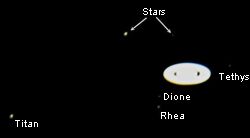 |
By overexposing Saturn it is possible to pick up a few of its satellites.
Date and Time: 5th October 2003 03:50 UT
Set-up: ToUcam 740K on the LX200
Capture: K3CCDTools, 959 frames, high gamma, 1/33", 78% gain, meter 255
Processing: Registax, X2 Mitchell, 582 frames stacked, all wavelets = 10
Brightness -30, shrunk back to the original size.
|
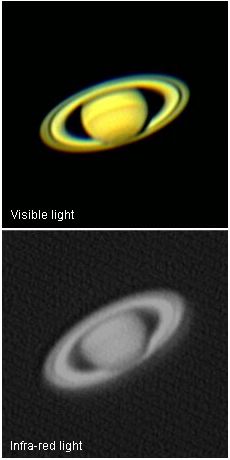 |
Date and Time: 25th September 2003 03:05 (vis) and 02:46 (ir) UT
Set-up: ToUcam 740K with X2 lens on the LX200
Capture: K3CCDTools,
Visible image: 1008 frames, low gamma, 1/25", 58% gain, meter 225
Infra-red image: 1015 frames, low gamma, 1/25", 100% gain, meter 175
Processing: Registax, X2 Mitchell,
Visible image: 470 frames stacked, wavelets 2-4 = 10
Infra-red image: 1015 frames stacked, wavelets 4-6 = 10,
Brightness -90
Both images shrunk back to their original size.
|
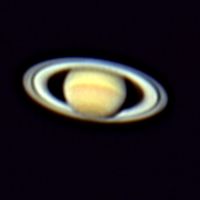 |
Date and Time: 17th September 2003 05:04 UT
Set-up: ToUcam 740K with X2 lens on the ETX125
Capture: K3CCDTools, 1182 frames, low gamma, 1/25", 80% gain, meter 185
Processing: Registax, X2 Mitchell, 603 frames stacked, wavelets 4-6 = 10,
shrunk back to the original size.
|
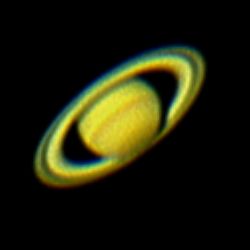 |
Date and Time: 16th September 2003 03:44 UT
Set-up: ToUcam 740K with X2 lens on the LX200
Capture: K3CCDTools: 610 frames, low gamma, 1/25", 70% gain, meter 204
Processing: Registax, X2 Mitchell, 178 frames stacked, wavelets 2-4=20 5=10,
shrunk back to the original size.
Photoimpact, Gaussian Blur 2 pixels,
Unsharp Mask 30,5.
|
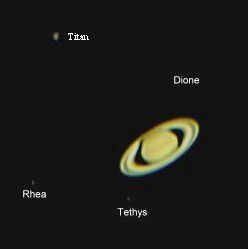 |
By over-exposing the picture it is possible to capture some of Saturn's satellites.
In this picture, a correctly-exposed picture of Saturn has been superimposed on the
original over-exposed image. This image has South at the top.
Date and Time: 16th September 2003 03:15 UT
Set-up: ToUcam 740K on the LX200
Capture: K3CCDTools, 608 frames, high gamma, 1/25", 60% gain, meter 255
Processing: Registax, 582 frames stacked,
|
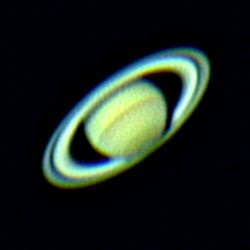 |
Date and Time: 7th September 2003 03:31 UT
Set-up: ToUcam 740K with X2 teleadaptor lens on the LX200
Capture: K3CCDTools, 1057 frames, low gamma, 1/25", 60% gain, meter 152
Processing: Registax,
|

